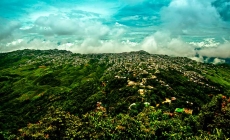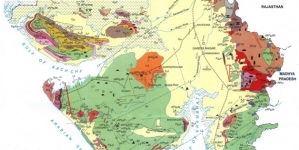-
Rajasthan - November 4, 2015
-
Haryana History - November 1, 2015
-
Haryana - November 1, 2015
-
Mizoram Minerals - March 3, 2015
-
Mizoram Hotels - March 2, 2015
-
Mizoram Culture - March 2, 2015
-
Mizoram Tourist Places - March 2, 2015
-
Mizoram History - March 1, 2015
-
Chhattisgarh Minerals - February 27, 2015
-
Chhattisgarh Hotels - February 27, 2015
Gujarat may have earned the position of being most industrialized and developed states of India but the people of Gujarat have preserved the rich Culture and tradition of Gujarat.Hence, it is rightly said “JyaJya Vase Gujarati, tyatya Vase Gujarat” (Wherever in the world lives Gujarati, there live Gujarat) and the state stands as “Heart of India” due to Multiculturalism.
From food to faiths and beliefs Gujaratis carry a unique culture in almost all the aspects of their lives. Shri Modi had once beautifully described the importance of the culture and its uniqueness “Never forget your ancestors, your roots and the place where you have come from. Always remember one thing, have a strong bond with your culture, tradition and native place as in these lie our uniqueness and oneness!” he said
A journey towards the Rich Culture of Gujarat:
The Traditional Gujarati Food:
Vegetarianism is a dominant thread in Gujarati society. Geographically Gujarat is divided into 4 parts, mainly North Gujarat, Kathiawad, Kutch and South Gujarat therefore; there are some variations in eating habits and methods of preparations but the famous Gujarati dishes are Dhokla, Khandhvi, Undhiyu, Fafda, Thepla, Handvo, Ganthia, etc. A Traditional Gujarati Thaliis served in silver platterconsisting of Dal (lentils), rice, vegetables, rotisand it is incomplete without crispy fried Farsan,chaas(Buttermilk), sweetmeats, sour chutneys and pickles. The dinner basically consists of Bhakhri-Shak or Khicdi Kadhi.
Traditional Gujarati Dressing styles:
Patola Silk from Patan is renowned across the nation and is one of the biggest selling fabrics; in fact it is one of the finest hand woven sarees produced today. Gharchola and Panetar are the silk and zari woven saris tie-dyed or block printed; these are specifically worn by a Gujarati Bride. Besides, the Abhas (a traditional costume) of Kutch has entered the world of High fashion. Abha is the typical choli worn by women folk and Kanjari is a long blouse beautifully embroidered and the mirror work. ChaniaCholis are traditional dresses worn by females during navratri (the longest dance festival) while the men wear kediyas.
Traditional Gujarati Homes (Interiors):
With the rise in standard of living of Gujaratis they now live in well ventilated, furnished homes and flats yet, the rich heritage feel and ethinic living dwells in Gujarat.The traditional homes and wodden houses exist in rural Gujarat.Gujaratis not only dwell in houses with exclusive interiors but also care for birds and so, built a special “Chabutara” for bird feeding that is the beauty of many traditional homes in Gujarat.
Traditional Gujarati Ornaments:
Pachchikam jewelry originallyfrom Kutch, has nowacclaimed and is in trend these days. The unique aspect of Pachchikam is that instead gold it makes use of silver and is thus, quite affordable. Apart from this Gujarati women are very fond of carrying a bunch of keys on their waist and the key ring holder is generally made of silver. Other jewellery which a Gujarati womanwears ismangalsutra, earrings, necklace, rings and bangles.
Traditional Gujarati Languages:
The traditional Language spoken in Gujarat is basically known as “Gujarati”; the language is spoken by 46 million people and is 26th most spoken native language in the world. Apart from this the language differs according to the geographical locations like Surti, charotari, kathiyawadi and kutchi languages.
Gujarati Literature:
Gujarati Literature is segregated in 3 periods vizRasas, Phagus and Vilasas. While in the 16th century was strongly influenced two renowned poets Narismha Mehta and Bhalana. Besides, the contemporary Gujarati texts wereinitiated by Narmada Shankar (Ragrang), Mansukhram Tripathi, Naval Ram, K.M.Munshi and Mahatma Gandhi.
Traditional Gujarati Faiths & Beliefs:
Gujaratis believe in various gods and goddesses, besides give greatest importance to cow as they consider it as mother “Gau-Mata”. Gujarati Jains occupy a significant place in Gujarati society and economy as well. The lifecycleceremonies are performed by Brahmans; the most important ceremonies in the lives of Gujaratis are birth, thread ceremony, marriage and death. The major festivals are Navratri and Diwali. Navratri is the festival exclusively celebrated in Gujarat, it is festival of “nine nights” involving important folk dance performed by both males and femals known as Ras and Garbas. Ultimately, Gujaratis are full of life and are often found mingling and enjoy all religions without differentiating the castes or communities.
“We feel very proud and privileged to be born in the land of Gandhi, to be speaking the same language as Gandhi did, to be living on the banks of the river where Mahatma built his ashram.” Shri Narendra Modi.
References:
http://www.indfy.com/gujarat/languages.html
http://www.indianmirror.com/languages/gujarati-language.html
http://www.gujaratindia.com/about-gujarat/culture.htm
http://www.culturalindia.net/jewellery/types/pachchikam-jewelry.html
http://www.gujaratindia.com/about-gujarat/culture.htm
http://www.gujaratinformation.net/downloads/guj_pak_23_01122011.pdf
http://indiancostumes.indianetzone.com/1/gujarat_costumes.htm

















